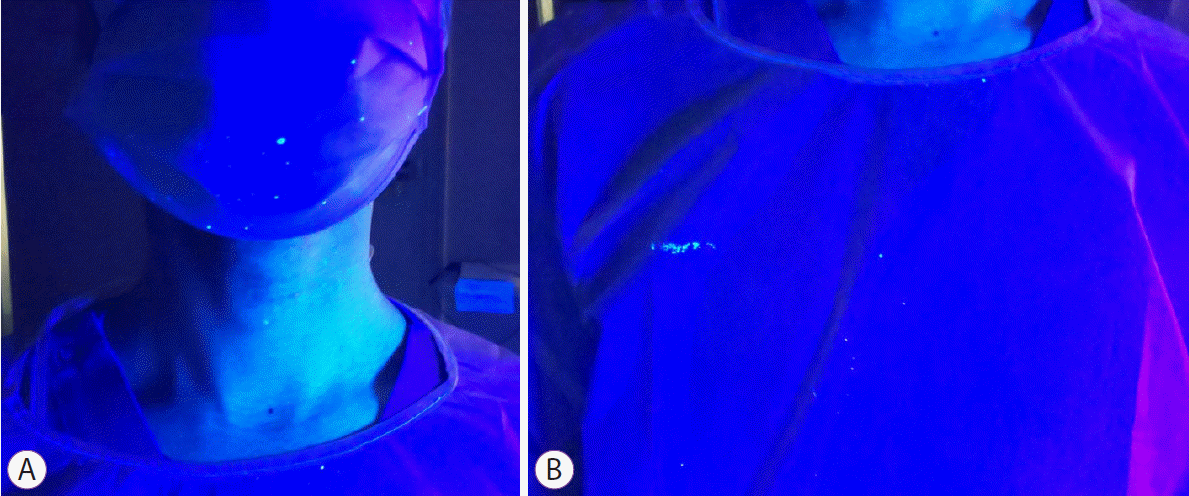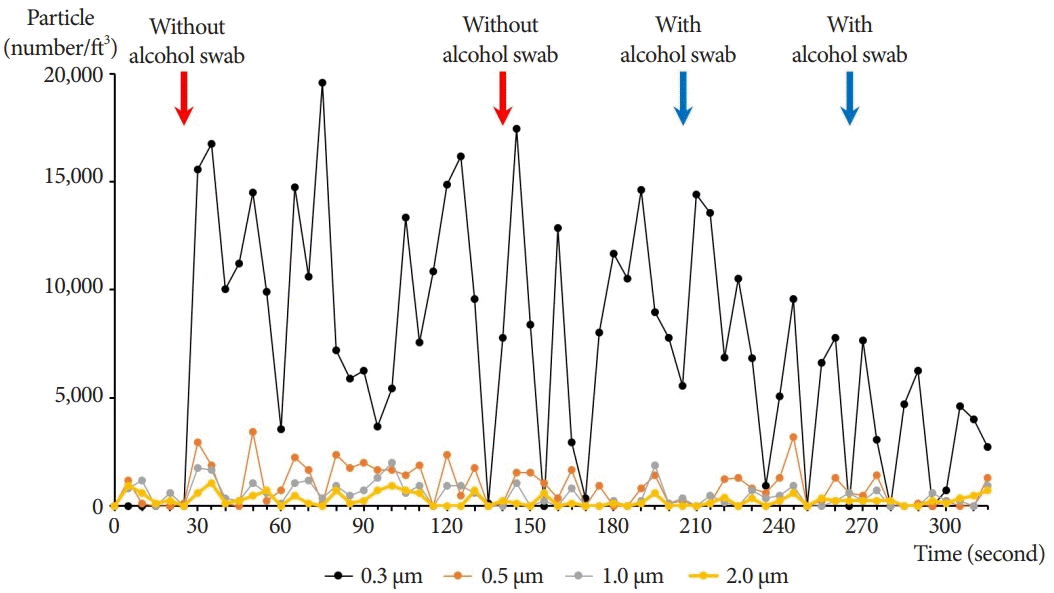According to reports, the potential transmission routes of the Coronavirus Disease 2019 (COVID-19) infection include contact, droplet, and airborne transmission [1,2]. Therefore, many strategies to reduce aerosol spread by patient coughs during endoscopy have been reported, such as plastic cube barrier, vinyl-box, modified surgical mask, and glove-covered mouthpiece [3-6]. Endoscopic biopsy for suspected malignancies should be performed for diagnosis confirmation even in the COVID-19 era [7,8]. However, to our knowledge, there are no reports of precautions focusing on potential contamination during biopsy. First, a patient’s contaminated fluids, which potentially exist in the instrument channel of the endoscope, could splash from the biopsy valve on the channel port into the endoscopist’s face. Moreover, infection risk is higher because of the close distance to the endoscopist’s face [9]. Second, it should also be considered that long and elastic biopsy forceps have an unexpected risk of contact transmission when the forceps are pulled out from the channel port. Here, we present a method without harmful effects of using an alcohol swab not only to prevent contaminated fluid splash during biopsy, but also to deactivate severe acute respiratory syndrome coronavirus 2 (SARS-CoV-2) for the reduction of contact transmission after biopsy. We performed a demonstration to inspect the protective effect of the swab using an upper gastrointestinal training simulator (LM-022; KOKEN CO., LTD., Tokyo, Japan) and fluorescent dye (see Supplementary Video 1).
The first demonstration shows the endoscopic biopsy procedure using a training simulator without precaution for potential contamination. After the forceps were pulled out by an assistant, many fluorescent dye droplets were identified on the right forearm, chest, neck, and mask of the endoscopist by illuminating with ultraviolet light (Fig. 1A, B).
Next, we present the alcohol swab technique during biopsy to reduce contamination. Ahead of biopsy, an alcohol swab package was placed with a cellophane tape near the instrument channel port in order to quickly obtain the swab (Fig. 2A). The endoscopist removes the swab and continues to hold down the top of the biopsy valve, “sandwiching” the forceps to stabilize until the forceps are slowly pulled out by an assistant (Fig. 2B).
The last demonstration shows the endoscopic biopsy procedure with an alcohol swab. After the assistant pulled out the forceps, the fluorescent dye was absorbed in the swab. Ultraviolet light illumination revealed no scattering of dye on the endoscopist.
For further clinical examination, we evaluated the aerosol spread using the portable HHPC6 + Handheld Particle Counter (Beckman Coulter, Inc., Brea, CA, USA), while actual biopsies were performed using esophagogastroduodenoscopy (EGD). This device was positioned at the face height of the endoscopist and recorded the quantity of particles (0.3-2.0 μm) per cubic feet every 5 seconds in order to verify the endoscopist’s exposure to the aerosol. All values were normalized against the background particle count in the endoscopy room at the start of measurement. Fig. 3 shows the temporal changes in particle counts for each size during EGD. Most notably, the quantity of particles (0.3 µm) did not increase after the biopsy with alcohol swab compared to that without alcohol swab. The total number of particles (0.3–2.0 μm) measured for 30 s after two biopsies while using the alcohol swab was reduced to 59.4% compared to that without the alcohol swab (94,470/ft3 and 159,060/ft3).
Our demonstration using the simulator and fluorescent dye suggested that the alcohol swab technique could prevent contaminated fluid splash and contact with SARS-CoV-2 on the forceps. In particular, we believe that droplet infection via the instrument channel can be almost completely controlled by this technique. However, this simulation did not demonstrate the preventive effect of small aerosol particles that cause airborne infections. Therefore, using a particle counter, we showed that our alcohol swab technique could limit the spread of aerosol to approximately 60% during endoscopic biopsies; however, the actual protective effect against airborne SARS-CoV-2 infection remains to be ascertained. Additional experiments are needed to investigate the effects of alcohol swabs on the disinfection of SARS-CoV-2 and the prevention of contact transmission. However, we consider that alcohol swabs can inactivate SARS-CoV-2 more effectively than simple gauze because of the disinfection effect of ethanol itself [10]. Our technique using an alcohol swab, an easy, low-cost option, can prevent viral transmission by the avoidance of fluid and aerosol blowout from the channel and by disinfection of the forceps. This technique can be applied to any endoscope or a similar device. Therefore, a further protective effect might be obtained for essential endoscopic procedures during the COVID-19 pandemic, and this novel technique can be accepted as a standard precaution to ensure infection control during routine endoscopy even after the COVID-19 era.
Notes
Author Contributions
Conceptualization: Shusei Fukunaga, Taku, Manabe, Yasuaki Nagami
Data curation: Akira Higashimori
Formal analysis: AH, SF
Investigation: SF, Taku Manabe, Tadashi Ochiai, Mitsuhiro Kono, Masaki Ominami
Methodology: SF, YN
Project administration: SF, YN
Supervision: Yasuhiro Fujiwara
Validation: SF, YN, AH
Writing-original draft: SF
Writing-review&editing: YN
Supplementary Material
Video 1. A new method using an alcohol swab to reduce contamination during biopsy and simple demonstrations using fluorescent dye to inspect the protective effect. (https://doi.org/10.5946/ce.2021.027.v001).
REFERENCES
1. Huang C, Wang Y, Li X, et al. Clinical features of patients infected with 2019 novel coronavirus in Wuhan, China. Lancet. 2020; 395:497–506.

2. Morawska L, Cao J. Airborne transmission of SARS-CoV-2: the world should face the reality. Environ Int. 2020; 139:105730.

3. Sagami R, Nishikiori H, Sato T, Murakami K. Endoscopic shield: barrier enclosure during the endoscopy to prevent aerosol droplets during the COVID-19 pandemic. VideoGIE. 2020; 5:445–448.

4. Kobara H, Nishiyama N, Masaki T. Shielding for patients using a single-use vinyl-box under continuous aerosol suction to minimize SARS-CoV-2 transmission during emergency endoscopy. Dig Endosc. 2020; 32:e114–e115.

5. Maruyama H, Higashimori A, Yamamoto K, et al. Coronavirus disease outbreak: a simple infection prevention measure using a surgical mask during endoscopy. Endoscopy. 2020; 52:E461–E462.

6. Sasaki S, Nishikawa J, Sakaida I. Use of a Glove-Covered Mouthpiece during Upper Endoscopy to Prevent COVID-19 Transmission. Clin Endosc. 2021; 54:289–290.

7. Soetikno R, Teoh AYB, Kaltenbach T, et al. Considerations in performing endoscopy during the COVID-19 pandemic. Gastrointest Endosc. 2020; 92:176–183.

8. Han J, Kim EY. Sharing our experience of operating an endoscopy unit in the midst of a covid-19 outbreak. Clin Endosc. 2020; 53:243–245.

Fig. 1.
(A) Droplets of fluorescent dye illuminated with ultraviolet light identified on the neck and mask of an endoscopist. (B) Droplets of fluorescent dye found on endoscopist’s chest.





 PDF
PDF Citation
Citation Print
Print






 XML Download
XML Download